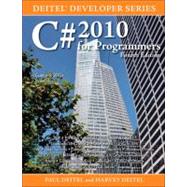The professional programmer’s Deitel® guide to C# 2010 and the powerful Microsoft® .NET 4 Framework
Written for programmers with a background in C++, Java or other high-level, object-oriented languages, this book applies the Deitel signature live-code approach to teaching programming and explores Microsoft’s C# 2010 language and .NET 4 in depth. The book is updated for Visual Studio® 2010 and C# 4, and presents C# concepts in the context of fully tested programs, complete with syntax shading, detailed line-by-line code descriptions and program outputs. The book features 200+ C# applications with 17,000+ lines of proven C# code, as well as hundreds of programming tips that will help you build robust applications.
Start with a concise introduction to C# fundamentals using an early classes and objects approach, then rapidly move on to more advanced topics, including multithreading, .NET 4, LINQ, WPF, ASP.NET 4, WCF web services and Silverlight®. Along the way you’ll enjoy the Deitels’ classic treatment of object-oriented programming and the OOD/UML® ATM case study, including a complete C# implementation. When you’re finished, you’ll be ready to build next-generation Windows applications, web applications and web services.
Check out the related LiveLessons video product, C# 2010 Fundamentals: Parts I, II and III, containing 20+ hours of video synchronized to this book: www.deitel.com/livelessons.
-Practical, example-rich coverage of:
-.NET 4, Types, Arrays, Exception Handling
-LINQ, Object/Collection Initializers
-OOP: Classes, Objects, Inheritance, Polymorphism, Interfaces
-WinForms, WPF, XAML, Event Handling
-WPF GUI/Graphics/Multimedia
-Silverlight®
-Lists, Queues, Stacks, Trees
-Generic Collections, Methods and Classes
-XML®, LINQ to XML
-Database, LINQ to SQL
-ASP.NET 4.0, ASP.NET AJAX
-Web Forms, Web Controls
-WCF Web Services
-OOD/UML® Case Study
Visit www.deitel.com
-For information on Deitel’s Dive Into® training courses offered worldwide visit www.deitel.com/training
-To license Deitel book and/or LiveLessons video content for your learning management system, e-mail deitel@deitel.com
-Download code examples
-Follow Deitel on Twitter® @deitel and Facebook® at www.deitel.com/deitelfan/
-To receive updates for this book, subscribe to the free Deite® Buzz Online e-mail newsletter at www.deitel.com/newsletter/subscribe.html







